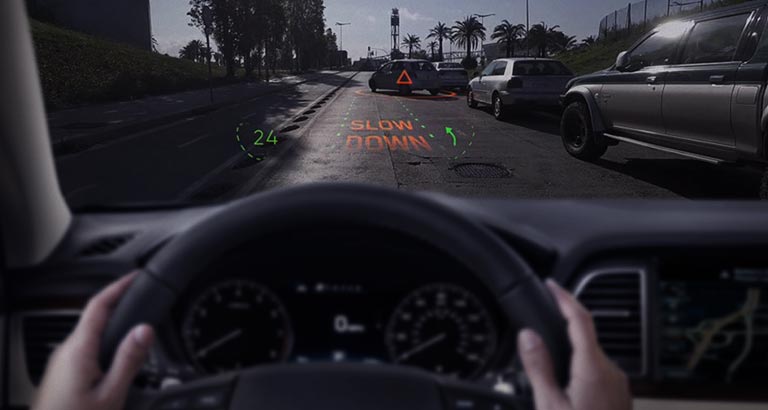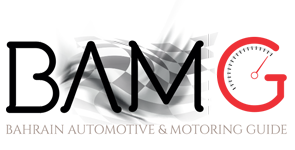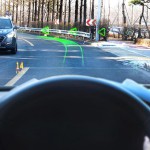Hyundai Motor Group, in collaboration with Swiss deep-tech startup company WayRay AG, has unveiled the world’s first Holographic Augmented Reality (AR) Navigation System equipped in the Genesis G80 at CES 2019. The technology was on display throughout CES 2019.
Hyundai CRADLE, the hub for Hyundai’s open innovation business, decided to strategically invest in WayRay last September in recognition of its leadership in holographic AR technology and its future growth potential. Prior to this initial investment, Hyundai Motor Group had been conducting its own preliminary research on applying holographic technology to vehicles in early 2017 and later expanded its commitment to producing quality parts with WayRay. The two parties have continued to develop holographic AR navigation technology in mass-produced vehicles, with long-term road tests in South Korea to minimise system errors.
“This demo car is the first step of the proof of concent (PoC), but is an important step towards technology driven innovation,” said Yunseong Hwang, director of Open Innovation Business Group from Hyundai Motor Group. “Future mobility windshields will be more than just a piece of glass. AR holographic powered glass will serve as a platform to provide new services and open up new in-vehicle experiences.”
The biggest advantage of a holographic AR navigation system built into the vehicle is that the stereoscopic image is displayed on the actual road and appropriately adjusted in accordance with the specific viewing angle of the driver, thereby delivering accurate driving guidance. The driver can enjoy vivid and precise holographic images without wearing a headset. The direction of movement is kept precise through the vehicle speed in real-time, and projecting navigational alerts through the windshield onto the road allows drivers to navigate safely while looking ahead undistracted.
 Additionally, while conventional head-up display (HUD) units project a reflected image indirectly through an LCD screen mounted on the dashboard, the holographic AR display projects an image through the windshield.
Additionally, while conventional head-up display (HUD) units project a reflected image indirectly through an LCD screen mounted on the dashboard, the holographic AR display projects an image through the windshield.
WayRay’s display shows not only navigational features — such as lane guidance, destination points, and current speed — in augmented reality, but also incorporates ADAS features like lane departure warnings and forward collision warnings. The virtual image of 1,310mm x 3,152mm is projected at a distance of 15m from the driver’s eyes; Hyundai Motor Group has refurbished its HUD to fit WayRay’s system and offer the optimised solution to drivers.
The two parties will continue to work closely together to expand holographic AR technology to display people, objects, buses, bicycle lanes and crosswalks, and additionally, further develop advanced ADAS functions such as a rear side warning system and the Highway Driving Assist (HDA) system.
In addition, they expect the incorporation of V2X (Vehicle to Everything) technology and connectivity features will allow data such as traffic signals, surrounding vehicle information, as well as road or weather conditions, to be provided in real time.
“As the automotive market is undergoing a profound AR technology-driven transformation, major automakers are quickly adopting AR solutions to find another competitive edge,” said Vitaly Ponomarev, CEO of WayRay. “I believe the strong partnership with Hyundai will help us scale up our deep-tech innovation to build customer-centric solutions at a meaningful scale and make driving more comfortable and safe for everyone.”
Hyundai Motor and Kia Motors are concentrating their research and development resources on acquiring AR navigation and other related technologies to improve upon and accelerate the next generation of displays and connected vehicles. Not only will this disruptive technology help Hyundai Motor Group achieve its vision of a more integrated and seamless blending of automotive technologies, but also assist in developing other closely related areas of interest such as wearable robots, smart-buildings, smart-cities and a plethora of other exciting possibilities.
Besides this holographic AR navigation demonstrated at CES 2019, Hyundai Motor exhibited a cocoon-shaped cockpit which allowed visitors to get a taste for freedom in mobility, while Kia Motors highlighted innovations that allow visitors to experience such technologies as the new Real-time Emotion Adaptive Driving (R.E.A.D.) System.



